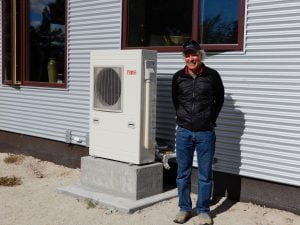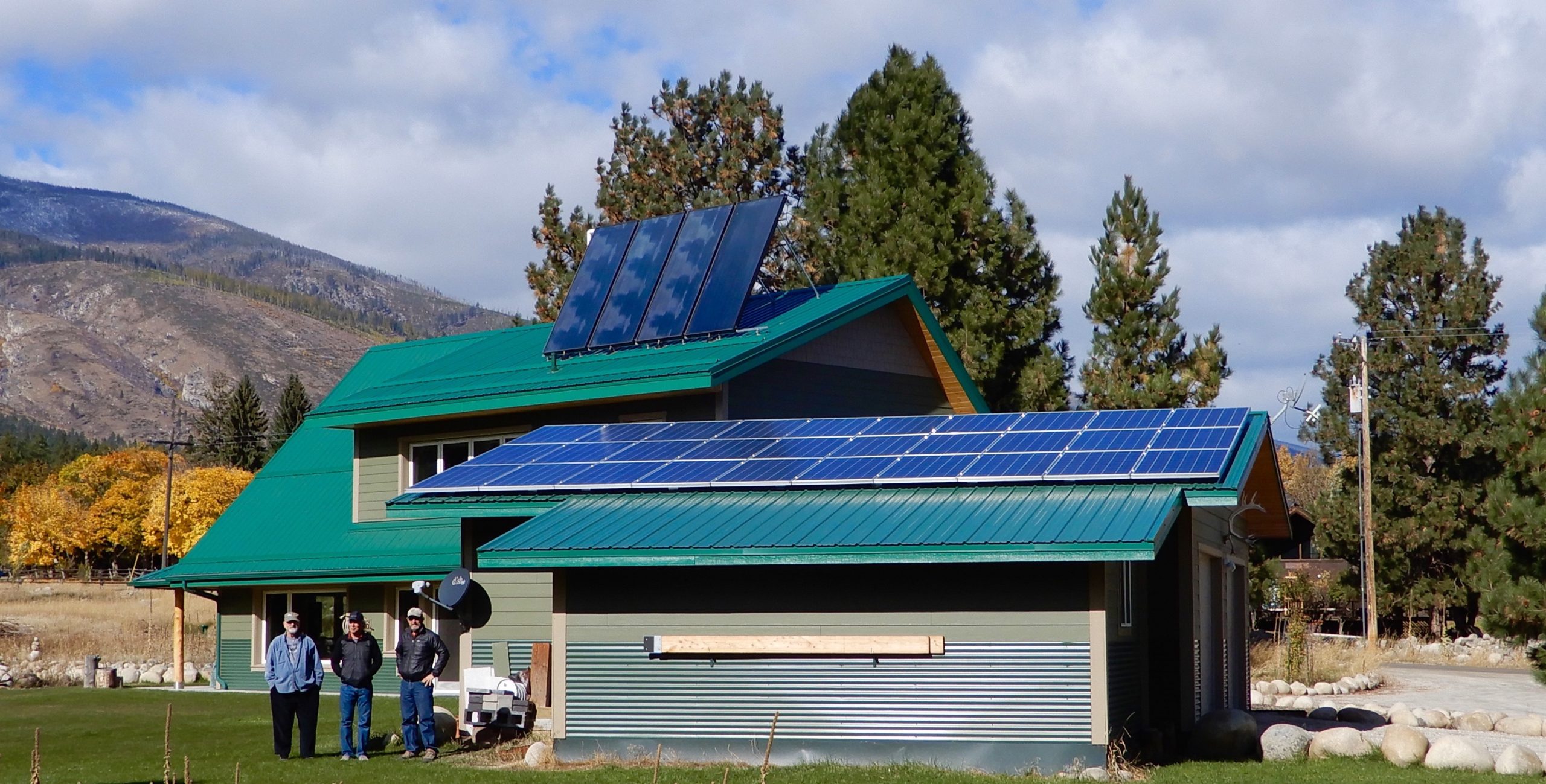Zero energy custom homes are done best when they are approached as a collaboration between client, designer, and builder. And the best collaborations come when each of these three actors fully engage their own role without spilling too far into other areas. The result is a building that meets the client’s needs and functions effectively at a reasonable cost.
The collaboration between builder Terry Davenport and homeowners Sidney and Belenda Mehlschmidt exemplifies the power of this collaboration. Sidney Mehlschmidt is a retired commercial pilot who has designed and commissioned two previous custom homes, giving him a good idea of his family’s needs and the skills required to translate them into physical form.
“I wanted to satisfy three design requirements,” says Mehlschmidt. “Universal design for aging in place, a farmhouse look that fits with the rural Montana culture, and a home that was highly-energy efficient.”
The Mehlschmidt home was completed in 2013 and covers 1,936 square feet with one bedroom on the first floor and a large, second-floor art studio/guest room including an adjacent bathroom. Their 7.5 kW solar electric system generates more electricity than he and his wife use on an annual basis. While their neighbor spends about $185 per month for utilities, they spend only $4.10 per month for the electric utility billing fee. The utility’s net metering contract allows them to accumulate credits for excess solar power generated in summer and then use those credits the following winter.
In addition to solar electricity, this home uses four solar thermal collectors to accomplish two tasks: provide domestic hot water and drive the in-floor, hydronic space heating system. The solar thermal system is backed up with a standard 50-gallon electric water heater wired so that both electric heating elements in the tank operate together.
Their builder, Terry Davenport of Natural Housebuilders, has been designing and building energy-efficient homes in Montana for around forty years (check). “It’s a form of performance art,” says Davenport. “You can’t see many of the features, but you can feel them.”
Integrated Design
Davenport praises the integrated design/build model because the functions are interdependent. In the more common situation where an architect or designer transfers the project to an independent builder, frequent communication and collaborative problem solving are absolutely necessary.
According to Davenport, zero energy homes can be cost competitive with conventional homes. First, small size reduces all costs, from permits to framing and from drywall to floor covering. Computer energy modeling can be used to optimize energy features. A zero energy house may often be more expensive to build, but it will be less expensive to live in. “I don’t charge as much as some other builders because I have my own crew to do some work that other builders would sub out,” he says. “It takes longer to build, but there is less overhead.”
By combining the design/build functions, Davenport streamlines the construction process. As one might expect, years of experience allow him to avoid common pitfalls of home building. Perhaps less obvious, but equally important, is his ability to quickly adopt new materials, techniques, and equipment. The construction industry is often criticized as being slow to change when, in reality, new ideas are appearing constantly. These cutting-edge techniques are almost always adopted first in custom homes driven by forward-thinking designers, builders, and clients.
Sidney Mehlscmidt gained a keen appreciation for energy efficiency while living in Anchorage, Alaska. Attending a Cold Climate Research Center seminar by Thorsten Chlupp of REINA LLC, convinced him that his next custom home would maximize insulation and air tightness. His design goals and drawings included these ideas.
Details Evolve
When Davenport was engaged as the builder, these ideas moved further toward reality. Having adopted the superinsulation creed, Davenport long ago surpassed typical 2×4 stud walls. In the Mehlschmidt home, the double-stud walls are filled with dense-pack cellulose insulation.
Double-studs offer plenty of space for insulation, but Davenport became disenchanted with tilting up heavy assemblies or framing the walls twice. So his building practices evolved into his current approach of a single wood frame with exterior foam sheathing. Now, he is using a single, 2×10 stud wall covered with 2 inches of extruded polystyrene sheets (XPS) attached to the exterior. Roof assemblies use the same materials with cellulose in cavities and rigid insulation on top of the rafters.
One unique element of Davenport’s approach is his method of assembling the wall standing up, instead of lying on the deck. “2x10s almost stand up on their own,” he says. “We attach the plate to the subfloor, then I stand up on a pipe scaffold. My crew toenails the bottom of each stud in place and I nail the top plate down.” This creative framing method is made possible by Davenport’s long experience as a hands-on builder and having his own permanent crew. With each project they learn something new and refine their approach.
Since the Mehlschmidt’s project was completed in 2013, several new ideas have become part of Davenport’s preferred construction package. One is the use of rockwool insulation. This form of insulation has been used for decades in Canada, but is still uncommon for the U.S. Rockwool batts have slightly more insulating value than fiberglass of the same thickness. For example, 5.5 inches of Roxul is R-23, as opposed to R-21 for fiberglass. Roxul also offers a rigid board product that can be attached to the exterior like rigid foam, and it can be used either above or below grade.
Embrace Change
In a brand new project completed this year, Davenport is demonstrating another innovation – a new Sanden CO2 heat pump. The advanced technology in this device allows exceptional cold weather performance. The outdoor compressor unit combined with an indoor 80-gallon water tank supplies all the domestic hot water and space heating energy needed by the roughly 1,000 square foot home. This technology shows great promise for the heating and cooling industry.

Terry Davenport, Natural Housebuilders, installed a CO2 heat pumps that provides both space and water heating in this Montana home.
Over the years, Davenport’s projects have shown that custom homes need not be expensive energy wasters. Instead, creative collaboration with his clients, crew members, and subcontractors have allowed him to forge a career based on progressive projects that have evolved directly to zero energy homes. One essential aspect of this movement is to identify the true impact that building quality and efficiency has on consumers. He summed up the idea succinctly: “There is a high cost to cheap construction.”

